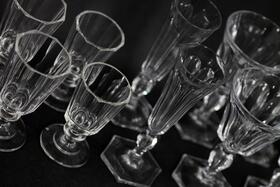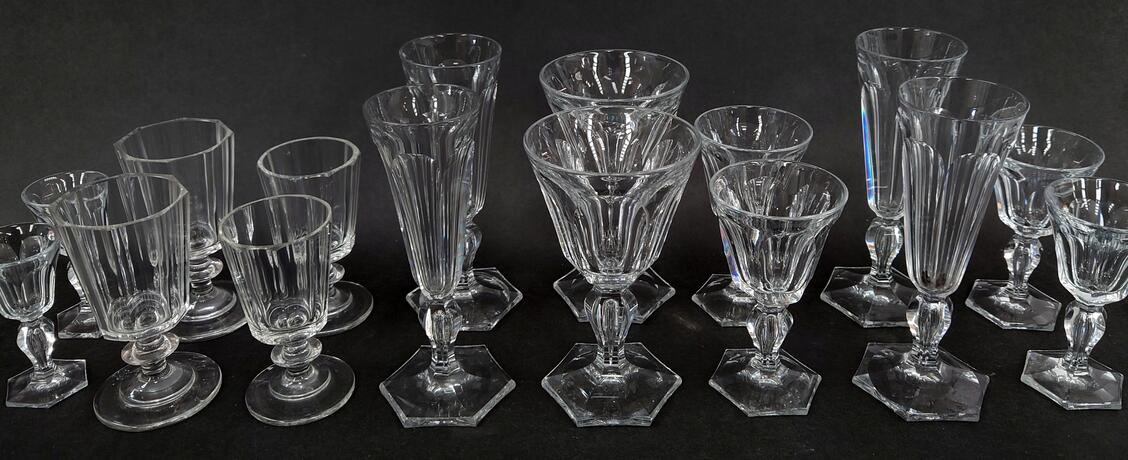Drinking in the Quality…
Drinking in the Quality…
By Elizabeth Talbot
Our earliest Western dining traditions were documented by the Ancient Greeks. Table-settings scenes are found in the Old Testament and in the writings of Homer. European table manners and other examples of chivalry date back as far as the 11th Century. However, table-setting became a significant Western craze in the late 1700’s, when the aristocracy used the practice as a form of self-expression and to display wealth, especially during formal dining.
On such occasions, table dressing included fine table linen, shiny silver and plate, and exquisite, expansive services in bone china or porcelain. By the 19th Century every course would require its own cutlery, with bespoke sizes and shapes of blade, tine and handle length, with strict order of deployment. Equally, every course would be served with the appropriate liquid accompaniment and each drink would be poured into a purpose-made drinking glass, so no fully laid table would be complete without a comprehensive suite of cut crystal or fine glass. Each place setting became a work of art and the rules of how to lay a table correctly were written into popular books of etiquette. Books about social etiquette were often extolled by titled ladies who used their privilege and experience to impress the importance of perfect behaviour upon people who strived to be upwardly mobile, and the popularity of the subject certainly led to upwardly mobile sales’ figures for the specialist volumes. For example, “Hints on Etiquette and the Usages of Society” created by Charles William Day, which was first published in 1834, had run to 28 editions by 1854. There were many other titles, too. 200 years later, and examples of these works are carefully preserved by museum libraries and sought after by avid collectors of the genre; some of these volumes are still influential guides in the 21st Century.
When setting out glassware, the intention was for each glass to be easily accessible to the diner and placed in a set order to match each course of the meal. Beginning with the water glass, positioned close at hand, just above the tips of the knives on the right-hand side, and curving in a gentle arc towards the near table edge, the champagne flute, white wine, red wine and sherry or dessert wine would follow. If port was served, that would be presented after the meal in yet another glass. And, of course, this rollcall of receptacles does not include the purposefully designed glasses for whisky, gin and tonic/ spirits, cocktails, or liqueurs usually included in the suited array. Add to these the variously shaped drink-specific decanters, claret jugs, and water jugs, all cut and decorated to match, and the most complete of suites can be truly spectacular. Needless-to-say, few full sets survive, but it is still possible to locate reasonably complete suites, and as the drinking experience can certainly be enhanced using beautiful glass, it is plain to see why such sets are considered such an attractive acquisition.
Some suites were manufactured by identifiable important makers, such as Waterford in Ireland, which was established in 1783 by brothers George and William Penrose, whose vision was to “create the finest quality crystal for drinking vessels and objects of beauty for the home”; others are anonymous but exquisite in terms of their refined cutting and exquisite engraved or etched decoration. Some suites of antique drinking glasses command a five-figure sum, however, depending on the age, calibre and completeness, a sizable part-set of matching design can be bought at auction for a more modest three figures.
In their next Special Antiques auction on June 1st, TW Gaze Diss Auction Rooms have many fine items to grace the most dazzling of formal dining tables, including a choice of choice part suites. A large quantity of handblown glasses originally from the Essenburg Castle. The set was made specifically for the Sandberg family who lived there at the time £1,000-1500 (small selection illustrated)
If this has wet your whistle, visit twgaze.co.uk for the fully illustrated Special Antiques catalogue containing an enticing array of wonderful pieces to be sold on 1st June, plus viewing details and bidding instructions. TW Gaze are pleased to be welcoming BBC television’s Celebrity Antiques Road Trip to this sale, too.

